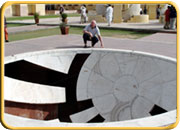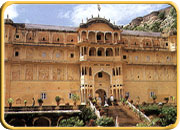Jaipur
Excursions in Jaipur
Sariska This
park is situated only 200 km from Delhi and 107 kms from Jaipur. Although larger
than Ranthambor, it is less commercialised and has less tigers but a similar
topography. It covers an area of 800 sq km in total, with a core area of approximately
500 sq km. The Northern Aravali Hills dominate the skyline with their mixture
of sharp cliffs and long narrow valleys. The area was declared a sanctuary in
1955 and became a National Park in 1979.
This
park is situated only 200 km from Delhi and 107 kms from Jaipur. Although larger
than Ranthambor, it is less commercialised and has less tigers but a similar
topography. It covers an area of 800 sq km in total, with a core area of approximately
500 sq km. The Northern Aravali Hills dominate the skyline with their mixture
of sharp cliffs and long narrow valleys. The area was declared a sanctuary in
1955 and became a National Park in 1979.The landscape of Sariska comprises of hills and narrow valleys of the Aravali hill range. The topography of Sariska supports scrub-thorn arid forests, dry deciduous forests, rocks and grasses. The broad range of wildlife here is a wonderful example of ecological adoption and tolerance, for the climate here is variable as well as erratic.
It is located in the contemporary Alwar district and is the legacy of the Maharajas of Alwar. Pavilions and Temples within Sariska are ruins that hint at past riches and glory. The nearby Kankwadi Fort has a long and turbulent history.
In morning and evening, wildlife in Sariska heads towards the many water holes, which litter the park, thus providing the guests with their best chance of viewing game. At some of these watering holes it is possible to book hides which are situated in prime spots for wildlife viewing. Sanganer
Sanganer is located 16 Kms from Jaipur. It is also known for exquisite Jain temples. Moreover, it is an important centre for crafts and hand-printed textiles that is internationally famous.The most beautiful temple in Sanganer is the ancient Shri Digamber Jain temple. The temple has fine carvings as those of the magnificent Dilwara temples of Mount Abu. Built in various phases with sky-high shikharas (spires), the temple represents an old style of architecture. The last phase was probably built in the 10th century. The beautiful nij-mandir (inner temple) is a stone shrine with three pinnacles. In the centre is an idol of Parshwanath with 7 serpent hoods. All around it, are carvings of lotuses, creepers and elephants pouring water from pitchers held in their trunks. But the main idol is that of Adinath, installed in the shrine behind this.
The town is most famous for its hand paper and mostly screen-printed fabric. The fabric is popular for small floral designs. A wide variety of material for apparels, furnishing and curtaining is available. Some of the traditional designs were produced in the patronage of the royal family. It is a beautiful sight to see brightly colour fabric drying out in the sun near the river.
Sawai Jai Singh II set up a paper business in Sanganer on the outskirts of Jaipur. It is said that in the 16th century, the ruler of Amber, Raja Man Singh, brought Kagzis to Sanganer (situated on the bank of Saraswati River, where abundant clear water was available). The town emerged as one of the biggest paper making centres in northern India. In between, however the industry did get a setback, but after independence, the Khadi and Village Industries Commission (KVIC) included the handmade paper in its agenda for promotion of crafts
Samode
The fort is an old fortified residence of the Nathawat family (hailing from chomu) that served as the Prime Ministers of the Jaipur Royal Court is located some 40km from Jaipur and 264 km from Delhi in the range of Aravali. This magnificent fort is as charming and
 romantic
in itself, and exhibits grandeur, good taste, class and elegance. The way to
the fort's main entrance is through the inside of the village, which can be
covered from the highway by a camel safari, with the locals welcoming the guests
with smiles and thrilling expressions. The inside of the fort reflects expressions
of the medieval architecture that is renovated a bit for the oriental formality.
The open courtyards in the centre has separate wings on the sides that extends
to 43 spacious rooms & suites having private balconies and views. The walls
are in warm colours to highlight the intricate marble work, the antiques and
the colourful art with traditional artefacts. The Durbar hall of Samode Palace
is one of the most beautifully painted chambers with glass & minakari work
and the same goes for the private restricted spaces- meant for the "zannanis",
women of the family.
romantic
in itself, and exhibits grandeur, good taste, class and elegance. The way to
the fort's main entrance is through the inside of the village, which can be
covered from the highway by a camel safari, with the locals welcoming the guests
with smiles and thrilling expressions. The inside of the fort reflects expressions
of the medieval architecture that is renovated a bit for the oriental formality.
The open courtyards in the centre has separate wings on the sides that extends
to 43 spacious rooms & suites having private balconies and views. The walls
are in warm colours to highlight the intricate marble work, the antiques and
the colourful art with traditional artefacts. The Durbar hall of Samode Palace
is one of the most beautifully painted chambers with glass & minakari work
and the same goes for the private restricted spaces- meant for the "zannanis",
women of the family.more jaipur excursions Select a holiday with us